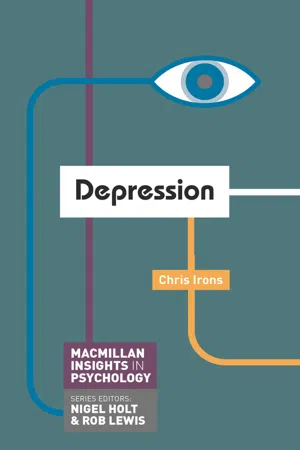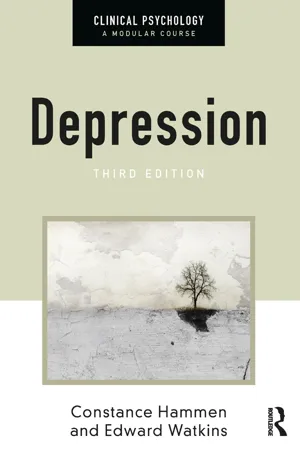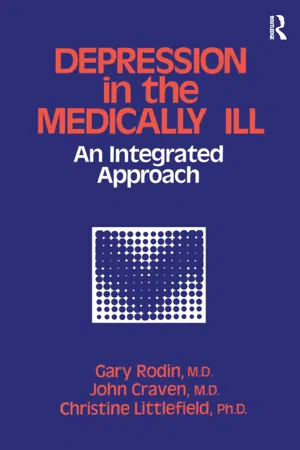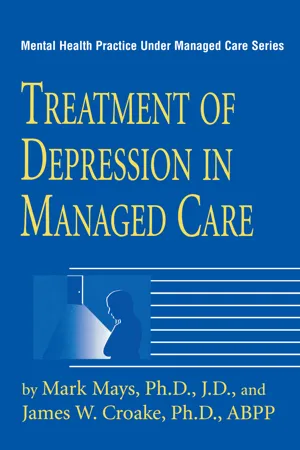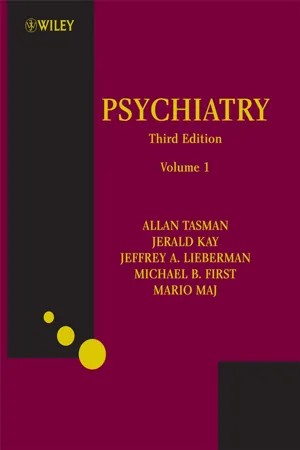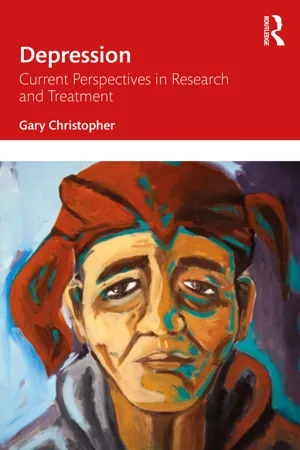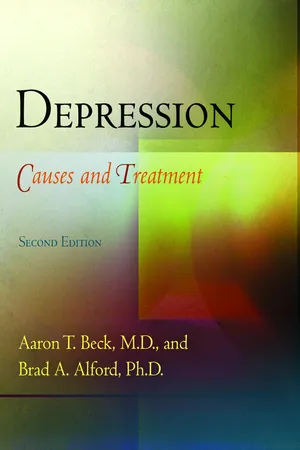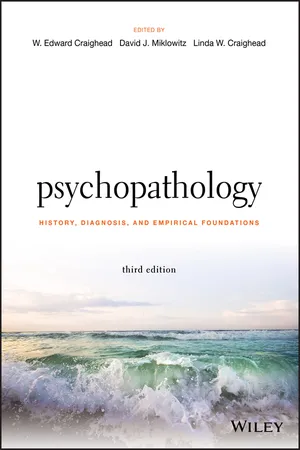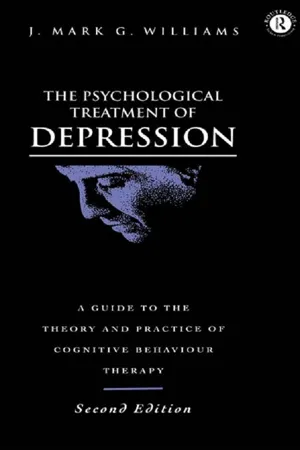Psychology
Biological Explanation of Depression
The biological explanation of depression suggests that imbalances in neurotransmitters, such as serotonin and dopamine, and disruptions in the endocrine system may contribute to the development of depression. Genetic factors, brain structure and function, and hormonal influences are also considered in this explanation. These biological factors are believed to interact with environmental and psychological factors to influence an individual's susceptibility to depression.
Written by Perlego with AI-assistance
Related key terms
10 Key excerpts on "Biological Explanation of Depression"
- eBook - ePub
- Chris Irons(Author)
- 2014(Publication Date)
- Bloomsbury Academic(Publisher)
Chapter 3Biological ExplanationsBiological explanations seek to understand how a variety of factors – including genes, anatomical brain structures and neurotransmitters – may be involved in depression. As we will find out in this chapter, there is no single biological profile or signature of depression but rather a variety of processes that may play an important role. Whilst reading this chapter, it is also worth holding in mind an important point: Depression, like all other human experience, is biological in nature; without a particular set of physiological changes in the brain and body, we would not ‘feel’ depressed. However, whilst this is very important, it is difficult to say whether, in simple terms, depression is ‘caused’ by biological factors or whether certain types of experience (e.g. environmental stress) affect our biology in a way that leaves us feeling depressed. This of course relates to ‘nature–nurture’ and ‘cause and effect’ debates. It is therefore important to hold in mind that these biological factors are related to depression through a complex biopsychosocial interplay, in which an individual’s unique biological, psychological and social characteristics interact to lead to depression.Neurobiological factorsFor many, the brain is the starting point for exploration of mental health problems, including depression. For a long time, scientists and health professionals have been interested in whether there are particular changes in the brains of depressed people, in comparison with those who are not depressed. It turns out that there are a variety of neurophysiological and biological changes in depression, including changes in certain brain structures, neurotransmitters and neurohormones.NeurotransmittersA neuron is a type of nerve cell that helps to form our nervous system. It is similar in many ways to other cells in the human body but has a special ability to transmit information to other cells and thus communicate information throughout the body. Neurons can communicate this information in both electrical and chemical forms. When they communicate in chemical form, they do this via neurotransmitters . Neurotransmitters are chemicals that operate between neurons, facilitating the transmission of a message or signal from one neuron to another. Neurotransmitters are released at part of a neuron called the axon terminal, and travel across the synaptic gap (the gap between neurons) before reaching the ‘receptor site’ of another neuron. They are then ‘taken up’ by the same neuron – a process known as reuptake. This process is displayed in Figure 3.1 - eBook - ePub
- Constance Hammen, Ed Watkins(Authors)
- 2018(Publication Date)
- Routledge(Publisher)
4 Biological aspects of depressionFor decades many have characterised the causes of depression as fundamentally biological while others have emphasised primarily psychological causes. Those who have emphasised biological/genetic origins point to the fact that depression seems to run in families, the effectiveness of antidepressant medications and that depression often involves biological symptoms such as changes in sleep, appetite, energy and activity level. None of these arguments is necessarily logically or empirically compelling as evidence for biological causation. More than ever before, however, scientific breakthroughs in knowledge and technology in genetics and studies of the brain have powered much of the research in psychopathology. This chapter attempts to characterise the current state of the rapidly-evolving understanding of depression from the biological perspective.Conceptual issues in the biology of depressive disorders
Before discussing the current understanding of the genetics and neurobiology of depression, several issues affect our understanding of the purpose, research design and interpretation of biological research. These are themes to employ when evaluating the quality and significance of research.Complexity
Scientific advances in the past 25 years or so have opened the door to every level of analysis from intracellular and molecular genetic aspects of brain function to the activities of whole regions of the brain operating together as circuits. Research involves many levels of the workings of normal and impaired human emotional and behavioural functioning including genetic, hormonal, cellular and intracellular, structural and functional aspects of the brain. Further, it is understood that such activities interact with each other in unimaginably complex ways – and that those activities are strongly shaped by environmental (including cultural) factors as well as the unfolding of these processes and outcomes over the course of normal and aberrant development starting from gestation. The term ‘multiple levels of analysis’ has been promoted by many (Cicchetti and Dawson, 2002; Hankin, 2015) to attempt to capture genetic, neural, endocrinological and environmental processes at the individual, family and community level, and to explore their changing effects over the process of development. For some, the concept is a mandate for ‘team’ efforts linking environment, development and multiple biological/genetic factors, but clearly such efforts are extraordinarily complex, expensive and necessitate multidisciplinary groups of experts. Others are moved to go deeper into narrower topics. In this chapter and throughout the book we try to highlight some attempts at multiple levels of analysis but such efforts are clearly at a nascent stage. - eBook - ePub
Depression And The Medically Ill
An Integrated Approach
- Gary Gary Rodin(Author)
- 2017(Publication Date)
- Routledge(Publisher)
It is often difficult to determine whether biological disturbances associated with a medical illness are specifically linked to depression. There have been some attempts to assess retrospectively the extent to which medically-related biological factors influenced the development of a depressive episode. A preliminary study in this vein by Kinzie et al. (1986) concluded that major depression resulted from a biological mechanism associated with a physical illness in 38 percent of a sample of 50 clinically depressed patients. In 14 percent of the sample, it was considered to be secondary to the combined effect of a physical illness and depressogenic medication; in 8 percent, an organic mood disorder was regarded as a direct complication of a medication. However, the method used to determine whether a biological mechanism was responsible for depression was not clearly specified. Others have reported that a medical condition either caused or contributed to a mental disturbance in from 5 percent to 42 percent of psychiatric patients, including those with mood disorders (Herridge, 1960; Davies, 1965; Koranyi, 1972; Hall et al., 1980; Summers et al., 1981). However, these studies also failed to specify the biological mechanisms purported to be involved in the association. This methodological problem plagues all research efforts in this area because criteria to establish a causal link between depression and a particular biological disturbance are extremely difficult to determine. As a result, current knowledge is limited in terms of the biological mechanisms involved in depressive illness that occurs concurrently with physical disease.Although our understanding of the biological underpinnings of depression has expanded rapidly during the past two decades, we still lack a comprehensive biological theory that delineates direct mechanisms by which depression is produced or the interplay between biological and psychological factors in the etiology of depression. In the absence of such a theory, biological mechanisms to explain depression associated with any given disease are most compelling when psychological explanations can be ruled out. For example, when symptoms of depression begin prior to other manifestations of the illness (e.g., depression preceding the onset of pancreatic carcinoma), the cause of the depression is more likely to be an early biological manifestation of the illness. However, in such cases it is still possible that a psychological response to physical alterations, not necessarily with conscious awareness, contributes to depression. Biological mechanisms again may be suspected when depression is more prevalent in one illness than in others with a similar prognosis, severity, or level of disability. For example, Schiffer and Babigan (1984) supported their proposition that biological mechanisms act to produce depression in multiple sclerosis (MS) by demonstrating that depression rates in MS are higher than rates in amyotrophic lateral sclerosis, a disease with similar physical features. Similarly, Robinson et al. (1984a) argued that biological mechanisms were implicated in the etiology of poststroke depression because depression did not appear to be related to the extent of disability or to stroke severity. - eBook - ePub
- Mark Mays, James W. Croake, Mark Mays, James W. Croake(Authors)
- 2013(Publication Date)
- Routledge(Publisher)
Theories of depression also vary in terms of the research supporting them. Within the social and medical sciences, empirical research has always been a way to validate theoretical understanding. Some theories, by their nature, lend themselves less well than others to empirical validation or refutation. Psychoanalytic theory is one of these. Other theories may be open to empirical inquiry, but practical considerations may constrain research efforts. For example, longitudinal research is expensive, and funding is often hard to obtain for studies that will not bear fruit for years, if at all. Theories that could be investigated by life-span research, therefore, will probably not be explored empirically. Funding for studies of drug effectiveness, relevant to certain biological theories, on the other hand, might be more available from the pharmaceutical companies that produce the antidepressant medicines being investigated. In short, there is hardly a consensus on the causes of depression, and the validation for the various views is often wanting.Biological TheoriesTheories of depression can be easily divided into those that refer to biological causes and those that refer to psychological causes. Biological theories may well be historically the most accepted, and they have strong currency today. A review article by Lewis (1967) about melancholia notes that even Hippocrates proposed a biological basis for melancholia. He believed that the accumulation of “black bile and phlegm” affected one’s mood state, “darkening the spirit and making it melancholic.”Many genetic studies have suggested that some mood disorders have a biological component. These studies imply that the biology of an individual, through genetic inheritance, plays a role in the etiology of depressive disorders.Twin studies compare the rates of similar diagnoses, called the “concordance rate,” for monozygotic twins, who possess identical sets of genes. There are repeated findings of a higher concordance rate in monozygotic twins than in dizygotic twins, who have a different genetic structure. In fact, a concordance rate of 63.8% for mood disorders has been observed in monozygotic twins, compared with a 14% rate for dizygotic twins (Wesner and Winokur, 1990). Adoption studies have attempted to separate genetically based susceptibility from environmental factors. Assessing the concordance rates in twins raised away from their biological parents might point toward the inheritability of certain disorders. Although all of these studies can be questioned on methodological grounds, multiple studies (e.g., Cadoret, 1978; Von Knorring, Cloninger, Bohman, and Sigvardsson, 1983) show a significant difference in concordance rates. These studies suggest that bipolar disorder very likely has, and certain forms of unipolar depression probably have, a genetic basis, and that other mood disorders may not be genetically based. Family studies acertain the ratio of ill relatives to the total number of relatives. This risk for a disorder, called the “morbid risk,” appears significantly high for both bipolar and unipolar disorders. - eBook - ePub
- Allan Tasman, Jerald Kay, Jeffrey A. Lieberman, Michael B. First, Mario Maj, Allan Tasman, Jerald Kay, Jeffrey A. Lieberman, Michael B. First, Mario Maj(Authors)
- 2011(Publication Date)
- Wiley(Publisher)
CHAPTER 21 Neurobiologic Foundations of Mood DisordersRonald Duman1H. Jonathan Polan2Alan Schatzberg31 Department of Psychiatry, Yale University, New Haven, CT, USA2 Department of Psychiatry, Columbia University College of Physicians and Surgeons, New York, NY, USA3 Department of Psychiatry, Stanford University, Stanford, CA, USAIn his classic paper, Mourning and Melancholia, Freud provided a vivid clinical description of what we now call major depression, as well as a pscyhodynamic formulation. Freud acknowledged that some forms of depression were biological in origin. The past 40 years have witnessed a major effort to understand the biology of depression and the major affective disorder, manic depression. This chapter highlights the history of biological approaches to mood disorders and then reviews recent advances in understanding the neurobiology of these complex disorders.Perhaps the major development in the past decade has been a shift from a view of depression as a relatively straightforward disorder of monoaminergic function to a more nuanced view of multiple causal steps ranging from alterations in neuronal second messenger systems to dysregulation of growth factor, peptide, and transmitter systems. These approaches have led to the investigation of decreased activity of neurotrophins and neurogenesis in specific brain regions and to altered activity in novel circuits. In each of these areas, available technology has generated new findings, which have spurred new theories of etiology.NomenclatureThe modern era of biological research on affective disorders depended on the development of a reliable classification. Investigators in the United Kingdom and Germany took the lead in classifying depressions. Three major distinctions were made. The first distinguished endogenous from nonendogenous depression. Endogenous depression referred either to a depression that was not precipitated by external events or to depression with prominent biological symptoms akin to melancholia. Over time it was recognized that some patients developed severe melancholic depressions that were clearly precipitated, so that the diagnostic significance of external precipitation for major depression was dropped in the American Psychiatric Association’s Diagnostic and Statisti cal Manual of Mental Disorders - eBook - ePub
Depression
Current Perspectives in Research and Treatment
- Gary Christopher(Author)
- 2023(Publication Date)
- Routledge(Publisher)
Chapter 3 Models of depressionDOI: 10.4324/9781315688879-3Biological model
Genetics
Genetics does seem to play a significant role in depression. Familial risk is higher in those who develop depression early on (1 ). Precisely what the mechanism is here is not yet clear. There seems to be a proneness to suffer hardship and a tendency to become depressed (2 ). Several factors have been identified as potentially mediating this genetic susceptibility in individuals. These include how one responds to stressful situations, among other things. This, then, is a classic example of gene– environment interaction.Of interest here is the general finding that depression is recurrent in nature. This means that people are more likely to experience a subsequent depressive event in the future. There is evidence to show that subsequent episodes of depression are less dependent on the presence of environmental stressors (3 ).Endocrine models
Hypothalamic–pituitary–adrenal axis
The hypothalamic–pituitary–adrenal axis, the HPA axis for short, mediates the body’s response to stressful events. It seems to be particularly important in depression. This is because around half of those diagnosed with depression show hypercortisolemia; high cortisol levels, in other words. This is due to both an oversecretion of the hormone itself and a reduction in the negative feedback received by the hypothalamus and pituitary that normally regulates its levels.Some studies have produced findings that suggest elevated levels of cortisol play a causative role in depression. This is because reducing levels of the hormone results in a raising in mood (4 ). Also, antidepressants act to resolve issues with the negative feedback loop (5 - eBook - ePub
Depression
Causes and Treatment
- Aaron T. Beck, M.D., Brad A. Alford, Ph.D.(Authors)
- 2014(Publication Date)
- University of Pennsylvania Press(Publisher)
Part II Experimental Aspects ofDepressionPassage contains an image Chapter 9 Biological Studies of Depression Early Studies
The biological aspects of depression have received considerable attention. Thousands of studies have been reported in the literature; tests have been made of almost all the known constituents of the blood, the urine, and the cerebrospinal fluid; and careful pathological studies of the brain and other organs have been conducted. Yet, few “positive” findings have stood the test of time, and there is still very little basic knowledge of the biological substrate of depression.1The concluding words in this chapter as originally written by Beck (p. 153)2 were as follows: “With the tightening of the experimental methods it may be expected that much of the uncertainty surrounding the biological aspects of depression will be dissipated.” This has not yet occurred.In 1995, addressing the question of causality in biological processes of depression, Thase & Howland3 wrote that “few conclusions can yet be reached with certainty, even after 30 years of research” (p. 216). This judgment is consistent with that of other experts in biological studies of depression.Dubovsky and Buzan4 reviewed several factors that contribute to the complexity. One problem is the enduring diversity of phenomenology and comorbidity within the definitions of the various disorders, despite progress made in Research Diagnostic Criteria and in DSM-IV . Another is that there is no reason to think there is a single cause of any mood disorder.Even if there were a single cause, that would not mitigate the complexity of identifying it. As an example, Dubovsky and Buzan pointed out that in researching inherited factors, one abnormal gene may lead to a protein that causes a positive symptom, yet another gene may fail to produce a protein that would regulate the positive symptom produced by the first. - eBook - ePub
Psychopathology
History, Diagnosis, and Empirical Foundations
- W. Edward Craighead, David J. Miklowitz, Linda W. Craighead, W. Edward Craighead, David J. Miklowitz, Linda W. Craighead(Authors)
- 2017(Publication Date)
- Wiley(Publisher)
Inflammation may be particularly relevant to three populations of depressed patients: individuals with treatment‐resistant depression (Strawbridge et al., 2015), chronic medical illness comorbid with depression (Evans et al., 2005), and depression associated with early‐life stress (Nemeroff, 2016). In some patients, exposure to trauma or stressful childhood experiences may be a variable connecting risk for depression, chronic medical illness, and inflammation (Nusslock & Miller, 2015). For example, patients with histories of childhood trauma have an elevated risk for depression that is often chronic in course (Nemeroff, 2016), and they also have elevated risk for a variety of common, chronic, and progressive medical diseases, including coronary artery disease (Goodwin & Stein, 2004).An Integrative Model of Depression
It is important to understand the psychological and biological research within the context of an overall interactive and developmental conceptual model of depression. In Figure 7.3 , we present a schematic representation of a model that incorporates the various aspects of depression outlined in this chapter. The reviewed empirical data fit within this theoretical framework that also serves heuristically to guide future research and clinical intervention.A Graphic View of an Integrative Model of DepressionFigure 7.3The diathesis‐stress model has been noted in several places in this chapter. Within this integrative model, the diathesis may be biological (e.g., genetic or involving neural connectivity) or psychological (e.g., behavioral, cognitive, emotional). Importantly, the key concept is that the diathesis is neither unidimensional nor singular in its etiological role. Rather, it may include more than one variable in any of the domains categorized as individual variables.The schematic representation is best viewed as a snapshot or static description of what, in fact, is a dynamic and interacting set of variables within and across domains. In this model, the various depressive symptoms categorized earlier in this chapter occur within an environmental context. As children grow and develop, they are continually interacting with their environment, which includes a multitude of dynamic, causative factors that reciprocally influence the children across all individual domains. As Bandura (1969) articulated, the external environment influences the person, but it is a two‐way street in that the person has a reciprocal impact on the environment. This process of transactional development affects those variables both within and outside the individual. Furthermore, within the individual there are interactive processes across the various domains. For example, emotion regulation is an important variable in the development of depression and other disorders. On the one hand, emotional arousal and subsequent regulation may be a bottom‐up process in that it may originate in the limbic system. On the other hand, research has shown that emotions may also be regulated via top‐down processing that originates in the frontal areas of the brain (see Ochsner & Gross, 2007). Unraveling these processes and increasing understanding of their interrelationships will be essential to enhance the prevention and treatment of MDD. - eBook - ePub
- James Chambers, James Chambers(Authors)
- 2019(Publication Date)
- Omnigraphics(Publisher)
The genes thought to be associated with depression have diverse functions in the brain. Some of these genes may control the production (synthesis), transport, and activity of chemicals called “neurotransmitters,” which relay chemical signals that allow nerve cells (neurons) to communicate with one another. Other genes that may influence the risk of depression are involved in the growth, maturation, and maintenance of neurons, as well as the ability of the connections between neurons (synapses) to change and adapt over time in response to experience, a characteristic known as “synaptic plasticity.”Nongenetic FactorsNongenetic (environmental) factors also play critical roles in a person’s risk of developing depression. The disorder can be triggered by substance abuse, certain medications, or stressful life events (such as divorce or the death of a loved one). Other risk factors include difficulties in relationships or social isolation, unemployment, financial problems, and childhood abuse or neglect. Some physical illnesses, such as cancer, thyroid disease, and chronic pain, are also associated with an increased risk of developing depression. It is likely that environmental conditions interact with genetic factors to determine the overall risk of developing this disease.Other Causes of Depression There are many reasons why a person may have depression:- Family history. People with a family history of depression may be more at risk. But depression can also happen in women who do not have a family history of depression.
- Brain changes. The brains of people with depression look and function differently from those of people who do not have depression.
- Chemistry. In someone who has depression, parts of the brain that manage mood, thoughts, sleep, appetite, and behavior may not have the right balance of chemicals.
- Hormone levels.
- eBook - ePub
- J. Mark G. Williams(Author)
- 2013(Publication Date)
- Routledge(Publisher)
Chapter 2
Psychological models of depression I The behavioural background
In the 1960s and early 1970s, clinical psychologists concerned themselves mostly with the behavioural treatment of anxiety-based disorders: phobias, obsessions and general anxiety. Where other problems were tackled, it was because they were assumed to have an anxiety component, e.g. tics, stammering, sexual problems. Careful analysis of the situations in which the anxiety arose, followed by relaxation, desensitization, exposure, response prevention, massed practice, etc.—these were the staple diet of the behavioural practitioner. Somehow, depression was not thought the appropriate target for such interventions.Firstly, depression appeared more ‘biological’, and if so the behavioural aspects would be mere symptoms. The development of antidepressant drugs had appeared to confirm the theory that depression was the result of deficiencies in some combination of biogenic amines in the brain. Secondly, although some depression was thought ‘reactive’, where the trauma was great, the depressive response seemed understandable and not requiring any special theory. Where the trauma was little, and the depressive response apparently out of proportion, there were psychodynamic explanations available. Thirdly, the symptoms of depression are many and various. The earliest behavioural speculations about depression had spoken of depression as ‘extinction’ (behavioural repertoire being weakened due to insufficient reinforcement relative to the effort expended—the response cost). Yet such notions did not seem to do justice to the variety of symptoms in depression. Indeed, as we saw in the last chapter, a person may be diagnosed depressed on the grounds of low mood, suicidal ideas, appetite disturbance, sleep disturbance, feelings of self-reproach and concentration or memory problems, without reduced behavioural output or ‘extinction’ being a major feature. Yet it is with such behavioural formulations that this review of the background to cognitive-behaviour therapy must start. Whatever their deficiencies as complete explanations of the phenomena of depression, they were arguably the most significant development in clinical psychological theorizing since the interpretations of phobic reactions as conditioned emotional responses earlier in the century. They broke the mould of predominant explanations for depression: the biogenic amine theory on the one hand and the psychodynamic theory on the other.
Index pages curate the most relevant extracts from our library of academic textbooks. They’ve been created using an in-house natural language model (NLM), each adding context and meaning to key research topics.
